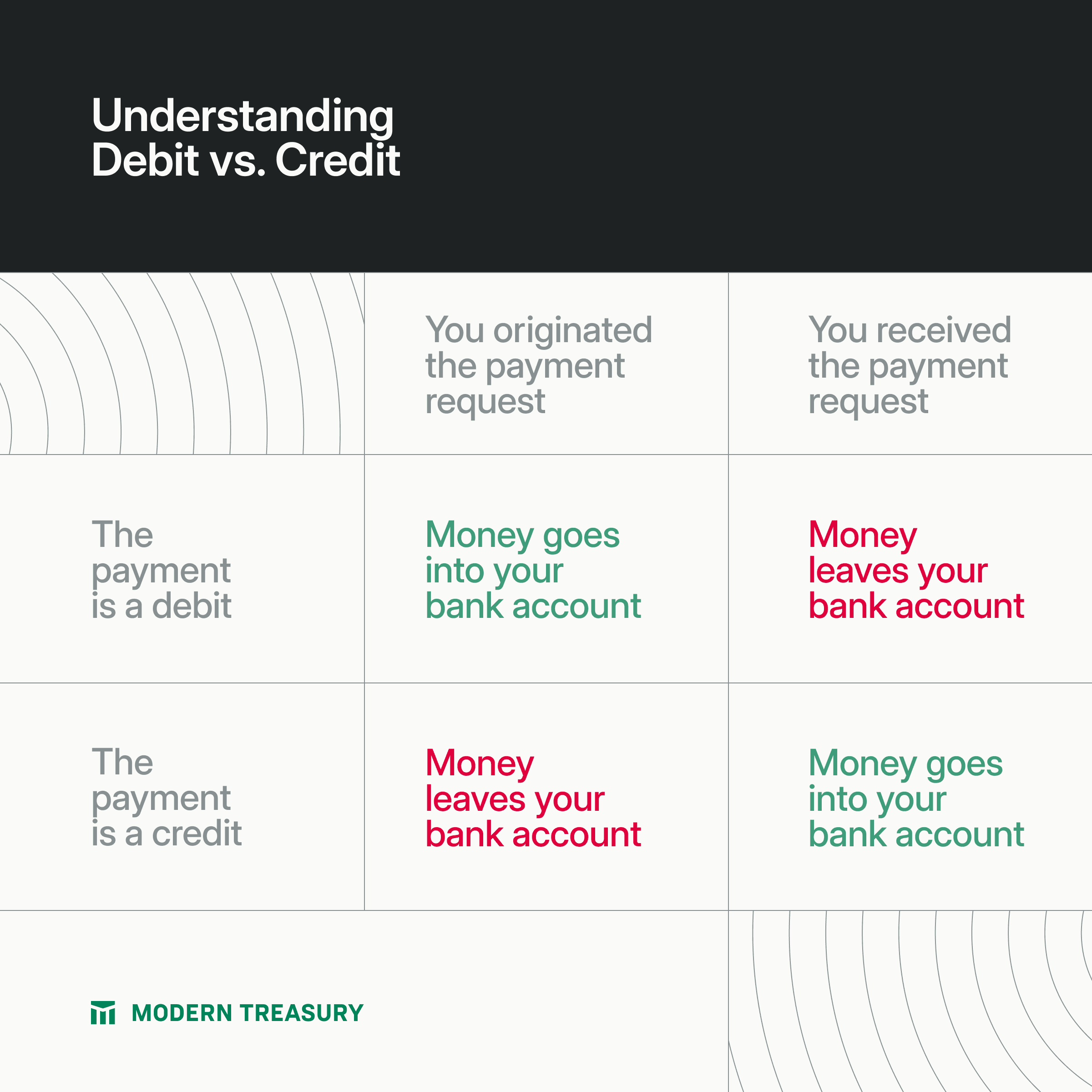Credits and debits are two kinds of ACH transactions. Whereas a credit involves depositing, or “pushing,” funds into a bank account, for a debit, funds are withdrawn, or “pulled,” from an account.
The Difference Between Credit and Debit
The difference between credit vs. debit for ACH is determined by the direction money is moving. An ACH credit deposits (or pushes) funds into a bank account. In the case of an ACH debit, money is withdrawn (or pulled) from an account. Banks in these fund flows are either Originating Depository Financial Institutions (ODFIs) or Receiving Depository Financial Institutions (RDFIs)—learn the difference between ODFIs and RDFIs here.
ACH credit is commonly referred to as direct deposit and widely used for fund flows like payroll; an ACH credit functions much like a digital check (minus the check). Let’s walk through a payroll example to illustrate how a credit works using a fictional company called BestJob:
- Once BestJob has confirmed your bank account (often via a microdeposit), BestJob will issue payment using ACH files sent to their partner bank, the ODFI.
- The ODFI will compile and batch process the ACH files received that day and send them to one of two clearinghouses—the Federal Reserve or EPN (the Electronic Payments Network).
- The next business day, the clearinghouse will sort ACH transactions and submit them to the correct banks. The employee’s bank, as the RDFI, will receive the ACH credit request from BestJob’s bank.
- When it receives the ACH files, the employee’s bank will deposit the paycheck into a settlement account, and the funds will likely appear as “Pending,” until the payment settles.
An ACH debit runs through the same process but in reverse. ACH debit is commonly used by businesses that collect recurring payments from consumers. Let’s walk through an ACH debit example using online bill pay for a fictional utility company called WaterWay:
- Once WaterWay has confirmed their customer’s checking account, the company will request payment by sending ACH files to their partner bank, the ODFI.
- After the ODFI has batch processed and compiled the ACH files, these files are then sent to a clearinghouse, either the Federal Reserve or EPN (the Electronic Payments Network).
- On the following business day, the clearinghouse will sort ACH transactions and send them to the correct bank. When the WaterWay customer’s bank (the RDFI) receives WaterWay’s ACH debit request, they will debit the customer’s account for the total bill and place the money into a settlement account.
- At this point, the customer will be able to see that WaterWay has deducted funds from their checking account. When the ACH debit is cleared by the clearinghouse, the payment is settled.
One complexity surrounding credit vs. debit relates to which party originates the payment and which party receives it.

The table above helps to clarify the four possible scenarios.
Learn
ACH (Automated Clearing House) is a payment processing network that’s used to send money electronically between banks in the United States.
ACH APIs enable companies with high transaction volumes to write software that automates payments over the ACH network.
An ACH credit refers to the process of electronically depositing, or “pushing,” funds into a bank account using ACH.
In an ACH debit, funds are electronically withdrawn, or “pulled,” from a bank account using ACH.
A Notification of Change (NOC) is used to notify the sender of an ACH payment to correct or change information related to a customer’s bank account.
A return is a credit or debit entry initiated by the Receiving Depository Financial Institution (RDFI) that returns a previously originated payment to the Originating Depository Financial Institution (ODFI).
ACH return codes identify the reason an ACH payment was returned by the recipient's bank. They make it easier to spot and resolve payment failures.
An ACH reversal refers to an erroneous ACH payment that a payment originator requests to take back, or reverse.
Credits and debits are two kinds of ACH transactions. Whereas a credit involves depositing, or “pushing,” funds into a bank account, for a debit, funds are withdrawn, or “pulled,” from an account.
FedACH is the automated clearing house (ACH) service of the Federal Reserve Banks.
Part of the FedACH system, FedGlobal ACH offers low-cost and efficient cross-border ACH payments.
The two kinds of financial institutions in the ACH network are ODFIs (Originating Depository Financial Institution) and RDFIs (Receiving Depository Financial Institutions).
A Standard Entry Class or SEC code is a three letter code that describes how a payment was authorized by the consumer or business receiving an ACH transaction.
US companies moving money internationally will likely weigh the pros and cons of SWIFT vs. Global ACH when it comes to attributes like speed and cost.
Payment rails are the underlying systems and networks that facilitate the movement of funds between parties in financial transactions.
ACH (Automated Clearing House) is a payment processing network that’s used to send money electronically between banks and financial institutions in the United States.
An electronic funds transfer (EFT), also known as a direct deposit, is the digital transfer of money between bank accounts. As digital transfers, they reduce the need for manual input and paper documents.
Global ACH can help companies move money from US-domiciled accounts across borders using local rails. Learn how and when to use this payment rail.
A Request for Payment (RFP) is an ACH Network message that can be used by businesses to send electronic invoices to their customers.
Same-Day ACH is an improvement to the ACH network that allows the processing of credit, debit, and return transactions several times a day.
A pre note or prenotification is a zero dollar payment to validate the account and routing details of a bank account before debiting or crediting it.
An International ACH Transfer—also known as Global ACH—is an ACH payment made cross-border from a US-domiciled account.